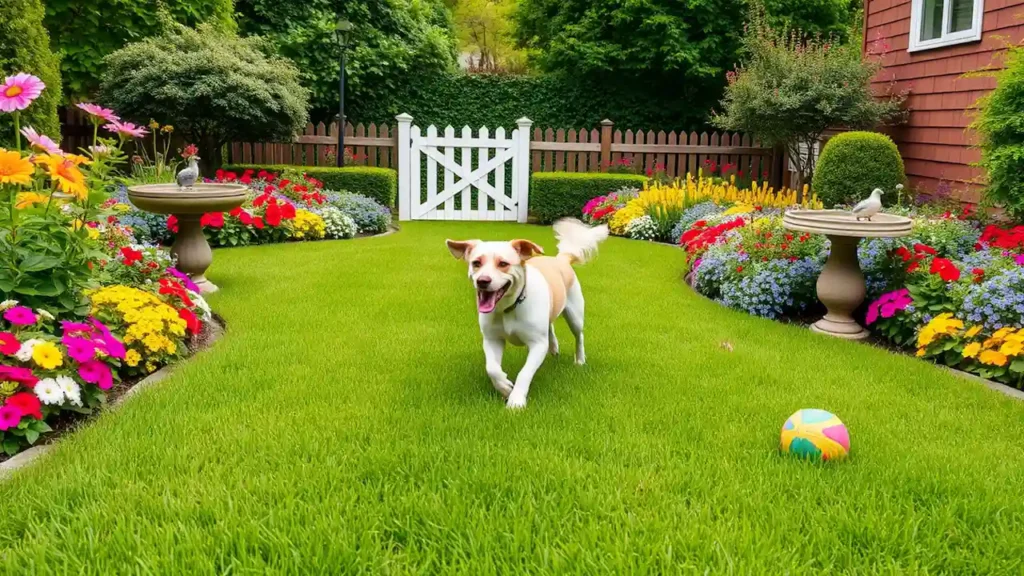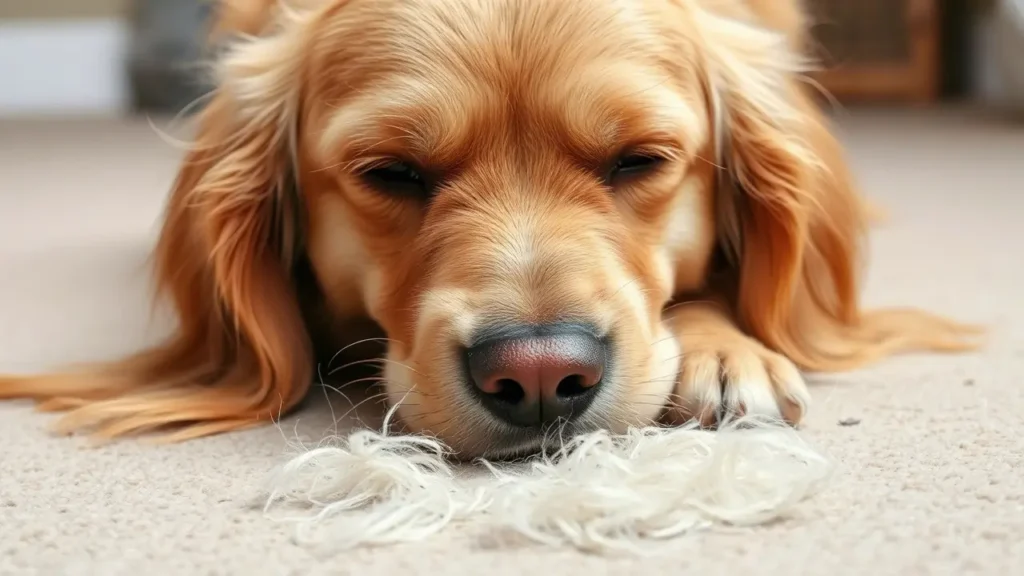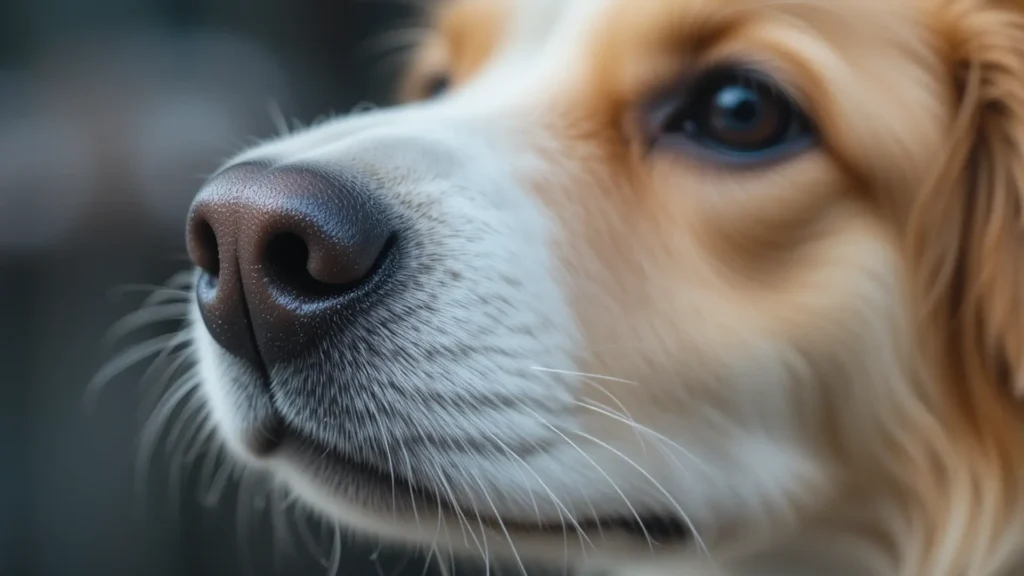A garden is more than just a patch of greenery. It’s a playground, a sanctuary, and sometimes a giant chew toy for your dog. Designing a dog-friendly garden requires balancing your dog’s instincts to run, dig, and explore with your vision for a beautiful, functional outdoor space. With thoughtful planning, you can create a yard that keeps your dog safe, and happy.
This guide dives deep into every aspect of building a garden that both you and your pup will love.
Prioritize Safety
Dogs are naturally curious. Their safety is the cornerstone of any dog-friendly garden. Eliminate hazards to ensure your dog can explore without risk.
A escape-proof fence is non-negotiable. Check for gaps, loose boards, and low spots where a determined dog might squeeze through or jump over. For small breeds, a 4-foot fence may suffice, but larger need 6 feet or higher.
Self-closing, lockable gates prevent accidental escapes. For diggers (Beagles or Dachshunds), bury chicken wire or concrete blocks 12-18 inches below the fence line to deter tunneling.
Choose non-toxic plants for the garden. Many popular plants are toxic to dogs. They include azaleas, lilies, oleander, sago palm, and foxgloves. Symptoms of poisoning range from upset stomachs to life-threatening organ damage. Safe plants for dogs include roses, sunflowers, marigolds, snapdragons, lavender, and petunias. If you’re unsure about a plant’s safety, keep it out of reach in containers.
Skip cocoa mulch. This contains theobromine (toxic to dogs), and sharp-edged gravel. Instead, use cedar or pine mulch. They are safe and deter pests. For pathways, choose smooth river rocks, flagstones, and compacted soil over jagged materials. Check for exposed nails, rusty tools, and chemical fertilizers left in accessible areas. Store these securely in a shed or locked bin.
Remove sharp stakes, low-hanging branches, and glass ornaments. That could injure a rambunctious dog.
Build a Durable Landscape for Rough Play
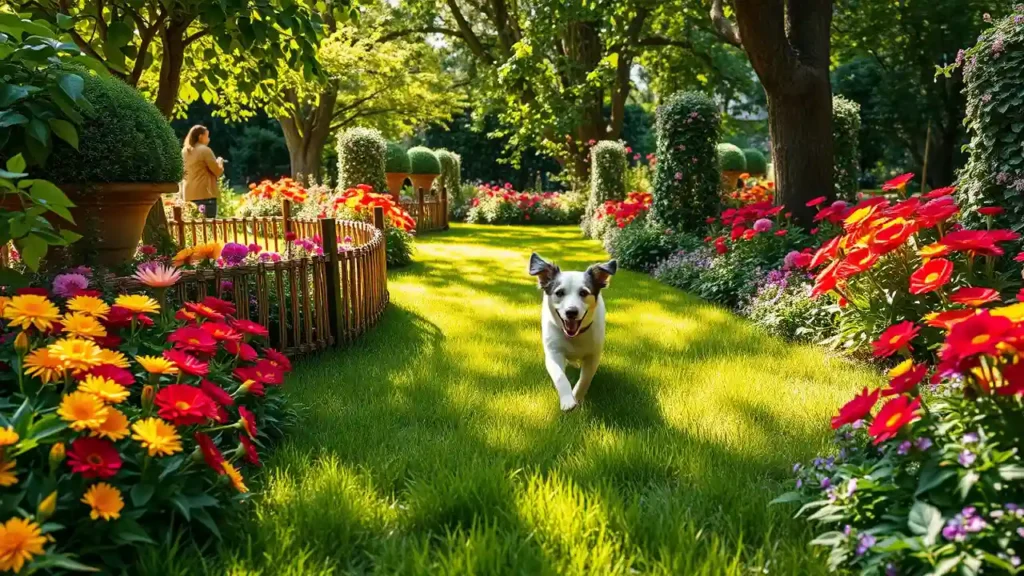
Dogs can be tough on gardens. A dog-friendly garden needs to withstand their enthusiasm without turning into a muddy mess.
Select tough plants. Fragile flowers won’t survive a playful pup. Opt for low-maintenance plants that can handle occasional trampling. Ornamental grasses (fountain grass or blue fescue), daylilies, viburnum, and rosemary are excellent choices. For ground cover, try clover or creeping thyme. They are soft on paws and resistant to wear. Group plants closely to create dense beds that discourage digging.
Reinforce high-traffic zones. Dogs create “racetracks” around the yard’s perimeter. Lay down flagstone, brick pavers, or artificial turf in these areas to prevent ruts. Artificial turf is especially practical. It’s low-maintenance, mud-free, and easy to clean. If you prefer natural grass, choose a tough variety like Bermuda or zoysia.
Young plants are vulnerable to curious noses and wagging tails. Use raised beds, low decorative fences, and plant cages to shield them until they’re established. For diggers, distract them with a designated digging area. If your dog loves to chew, apply pet-safe bitter sprays to discourage nibbling on stems.
Dogs track dirt, shed fur, and occasionally leave “gifts” in the garden. Choose darker-colored materials for paths and patios to hide stains. Avoid light-colored gravel that shows every muddy paw print. Regularly rake mulch to keep it tidy and prevent it from becoming a hiding spot for waste.
Design for Play and Exploration
A dog-friendly garden should tap into your dog’s instincts to run, sniff, dig, and explore. Incorporate features that engage their senses and energy.
Create a digging zone. Digging is a natural behavior for many breeds. Instead of fighting it, give your dog a designated digging spot. A corner of the yard filled with loose soil, sand, or mulch works well. Mark it with stones for a polished look. For small spaces, use a kiddie pool or wooden sandbox. Bury toys, bones, or treats to encourage digging in the right spot. Refresh the area occasionally to keep it enticing.
Dogs love to patrol and explore. Incorporate meandering paths made of grass, mulch, and smooth gravel. These invite sniffing adventures and give your dog a sense of territory. For extra fun, create a scent trail by lightly dragging a treat along the path for them to follow.
Install tunnels or obstacles. Tunnels spark curiosity and provide a safe way to channel energy. Purchase agility tunnels designed for dogs. Secure them firmly to prevent rolling. Low ramps, balance beams, and weave poles are great for active breeds. Start simple to build confidence, and always supervise during play.
Dogs experience the world through their senses. Add features that stimulate sight, smell, and touch. Plant fragrant dog-safe herbs. Mix textures to create a tactile playground. For visual interest, add tall grasses that sway in the breeze.
Set up play structures. Think beyond basic toys. A sturdy wooden ramp lets your dog climb and survey their domain. A pile of logs can double as a natural jungle gym. For high-energy dogs, consider a tire jump tailored to their size and skill level. Rotate toys to keep playtime fresh.
Host treasure hunts. Hide toys around the garden to encourage mental stimulation. Use hollow logs, under bushes, or in shallow holes to create a scavenger hunt. This is especially great for scent-driven breeds.
Provide Comfort and Shelter
Your garden should be a haven for your dog. Comfort and protection from the harmful elements are key.
Offer shade and cooling spots. Plant fast-growing shade trees, or install a pergola, awning, or large umbrella for instant cover. Avoid dense evergreens that trap heat. For a budget-friendly option, create a shade sail using weather-resistant fabric anchored to posts.
Include a water feature. A shallow fountain, splash pad, and kiddie pool gives your dog a place to cool off on hot days. Choose non-slip materials to prevent skidding. Ensure the water is clean and free of algae. Empty and refill pools regularly. For safety, avoid deep water features unless your dog is a strong swimmer and supervised.
A doghouse offers shelter from rain, wind, and intense sun. Look for one with good ventilation, a sloped roof, and insulation for year-round comfort. Elevate it slightly to keep it dry. For dogs who love to lounge, add a weatherproof pet bed in a shady spot.
Muddy paws can track dirt indoors. Place a towel, bucket of water, and portable paw washer near the entrance. For fancy setups, install a low outdoor faucet with a hose for quick rinses. Train your dog to wait at the door for a quick clean before heading inside.
Make Maintenance Easy
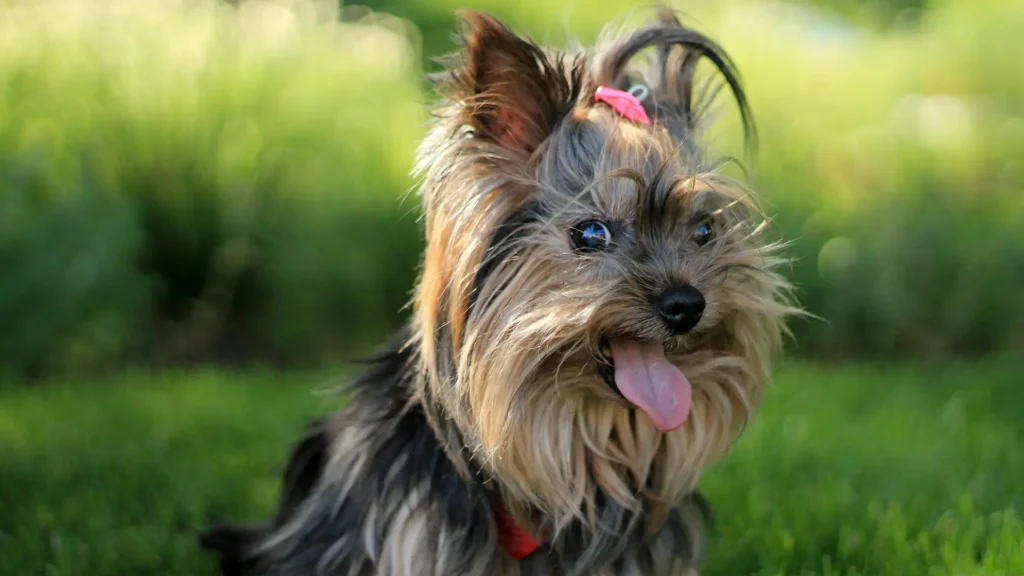
A dog-friendly garden should minimize chores so you can focus on enjoying time with your pup.
Dog urine can burn grass, leaving yellow spots. Train your dog to use a specific potty zone. For persistent issues, switch to urine-resistant ground covers. If digging is a problem, redirect your dog to their digging zone with consistent training.
Dog waste is inevitable. Make scooping easy. Install a small waste station with a sealed bin, biodegradable bags, and a scoop for quick cleanups. Check tall grass, bushes, and corners regularly for hidden piles. For odor control, sprinkle baking soda on problem areas.
Choose low-maintenance plants: Native plants adapted to your region require less water, fertilizer, and pruning. Lavender, salvia, and yarrow thrive with minimal care. Group plants with similar needs to streamline watering and maintenance.
Automate where possible. Install a drip irrigation system or soaker hoses to keep plants hydrated without daily effort. For larger yards, a robotic lawnmower can handle grass maintenance. Motion-activated sprinklers can deter digging in off-limits areas while doubling as a fun water game for your dog.
Train and Supervise
Even the most thoughtfully designed garden won’t be dog-proof without some training and oversight.
Establish boundaries. Teach your dog which areas are off-limits. Use positive reinforcement. Reward them with treats or praise for staying on paths or playing in approved zones. Redirect unwanted behaviors to their designated digging area.
Introduce the space gradually. When you first open the garden to your dog, supervise closely to observe their habits. Correct behaviors like chewing plants or jumping on raised beds immediately. Use a firm “no” and redirect to an appropriate activity.
Boredom leads to mischief. Keep your dog engaged with rotating toys. Schedule daily play sessions to burn energy. For working breeds, add jobs like carrying a toy basket to channel their instincts.
If your dog keeps targeting a specific spot, try pet-safe deterrents like citrus peels, vinegar sprays, and motion-activated noisemakers. Avoid anything harmful.
Add Personal Touches
A dog-friendly garden should reflect your personality while celebrating your bond with your dog.
Create shared spaces. Add a bench, hammock, and outdoor sofa where you can relax while your dog plays. String fairy lights for evening ambiance.
Incorporate fun details. Personalize the garden with a custom sign like “Rover’s Retreat” or “Beware: Happy Dog at Play.” Make paw-print stepping stones using a DIY concrete mold kit for a charming touch. For a whimsical vibe, add a colorful agility course painted in your favorite hues.
Plant a small veggie patch. Go for carrots or green beans. Include parsley or basil for your cooking. Keep them in raised beds to avoid curious noses.
Capture memories. Set up a photo spot with a sturdy wooden frame for seasonal doggie photoshoots. Drape it with flowers to mark milestones like birthdays or adoption anniversaries.
Adapt to Your Dog’s Needs
Every dog is unique, so tailor your garden to their personality, breed, and habits.
Border Collies, Jack Russells, and Dalmatians need space to sprint and burn off steam. Prioritize open lawns, long paths, and agility equipment. A flirt pole or tethered tug toy can keep them entertained for hours.
Terriers, Hounds, and Beagles love to dig and track scents. A large digging pit and scent-rich plants like lavender or mint will keep them occupied. Hide treats in different textures for sniffing games.
Chihuahuas and older dogs with mobility issues need gentler features. Use low ramps, soft surfaces, and shallow water features to accommodate their needs. Avoid steep slopes that could cause falls.
Labradors may see plants as chew toys. Provide plenty of appropriate chew toys and use bitter sprays on plants temporarily. As they mature, training will help curb destructive chewing.
Budget-Friendly Tips
Creating a dog-friendly garden doesn’t have to break the bank. Here are some cost-saving ideas:
Use old tires as climbing obstacles, stack fallen branches for a rustic border, or turn a cracked kiddie pool into a digging pit. Pallets can become plant dividers with a bit of sanding.
Ask friends for cuttings of dog-safe plants like roses or spider plants, which root easily. Buy seeds for sunflowers or marigolds. They’re cheap and grow quickly.
Check thrift stores or online marketplaces for outdoor furniture, ceramic pots, and agility equipment. Refurbish with pet-safe paint for a fresh look.
Start small. Focus on one feature, then expand as your budget allows. A few well-placed elements make a big difference.
A dog-friendly garden is a labor of love. By prioritizing safety, durability, and fun, you can create a space that celebrates your dog’s unique spirit while keeping your yard beautiful and manageable. Start with small changes and let your garden evolve with your dog’s needs. With patience and creativity, you’ll build a haven where both of you can thrive. So grab a shovel, leash up your pup, and get started.

